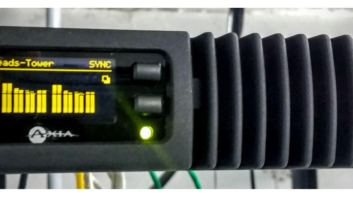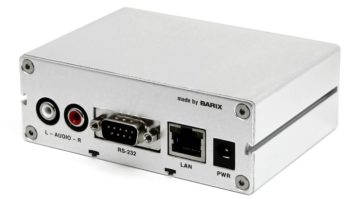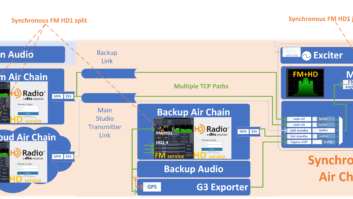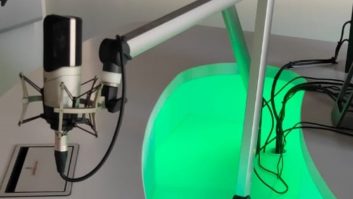
Fig. 1: Broadcast Electronics Digital Dashboard screen, showing data rates and audio presence on HD multicast channels.
One in a series of articles on getting the most out of your HD Radio investment.
If you already have an FM frequency, you have access to STL transmission without resorting to frequency searches in the congested 950 MHz STL band or unlicensed digital radios that may be subject to interference surprises. Traditional FM SCAs (analog subcarriers) do not work well for STLs, as they have insufficient audio bandwidth, cannot convey a stereo program and are noisy. FMeXtra can provide digital subcarrier service that can be used as an STL; however, the manufacturer of that technology is not keen on selling their hardware for that purpose, as they’d prefer to make their money on the sales of SCA receivers used traditionally for ethnic and other specialized audience program reception.
So what else can you do if you need an STL or ICR link to a repeater station or translator?
If you happen to be broadcasting an FM HD Radio signal, you can add multicasting streams, typically called HD2 and HD3. While you will need to invest in the IBOC hardware and pay a usage fee to iBiquity, all you’ll require on the far end is an FM HD receiver and an inexpensive FM antenna. As long as you can get your audio to the Importer computer, which combines HD multicast streams with the main HD channel, you can use it for an STL or ICR to reach that distant tower site.
Due to recent rule changes, FM translators may now be used as fill-in boosters for AM radio stations or for HD multicast channels. Their coverage area (60 dBu contour) may not overlap the originating station’s coverage area. The AM translator does not have to use the over-the-air AM signal as its source, but can instead take advantage of the higher quality of a direct studio-fed STL or ICR link. If that AM studio feed happens to be an HD2 and the translator is associated with the FM station, parent of that HD2, the non-overlapping coverage area is governed by the FM station’s coverage area rather than the AM station.

Fig. 2: This antenna system combines three translator signals, adding coverage of HD-only programming with 250 watt ERP each. REAL-WORLD EXAMPLE
In Keene, N.H., I have three FM translators multiplexed into one antenna mounted on a tower in the middle of town. One translator is associated with a directional AM station whose pattern faces away from town. Its 60 dBu contour is controlled by that AM station. Thus, its ERP is limited to 59 watts to prevent overlap. The two other translators are rebroadcasting a Class B FM’s HD2 and HD3 program services and are not restricted by contour overlap and thus have ERPs of 250 watts each. The FCC is permitting HD-only programming to also have FM signals so they can be heard by the majority of folks who do not have access to HD Radio receivers. Effectively, I have two low-power FM stations whose STLs are HD multicast channels.
THE HARDWARE
The audio chain starts at the studio with two Harris Neural processors, which are low bit-rate codec savvy. Delivery to the HD multicast Importer is via a pair of AoIP codecs (Barix) whose data flows through a Moseley Lanlink 900 MHz band duplex data radio to the host FM transmitter site. On the translator end, I’m using a pair of DaySequerra M4 tuners feeding a pair of Telos Omnia One audio processors, which in turn feed composite audio to a pair of Crown translators.
It works well and has been reliable with one caveat. These HD tuners can get confused if they see a burst of data errors and may become inoperative until rebooted. If I’ve had to restart an Importer or if I accidently unplugged the wrong Ethernet cable at the FM transmitter, as I once did, those tuners failed to come back up by themselves. So I highly recommend the use of remote power cycling technology such as smart outlet strips with either TCP/IP connectivity or a brute-force connection to a transmitter remote control system to save you a late-night trip to a tower site.
Send your HD Radio tips or column suggestions to [email protected].
Ira Wilner is chief engineer of Monadnock Radio Group, Saga Communications in Keene, N.H.






